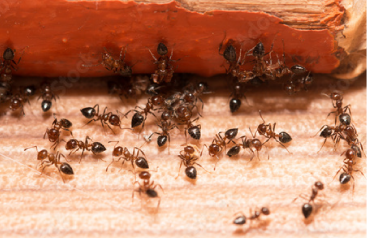The state of California is no stranger to pests large and small. While many people encounter ants in their daily lives, the last place you want to see them is your home or business. These tiny creatures are more than just a nuisance and can actually cause damage to your property. Just like us, they want to seek warmth during the winter months, so knowing what kinds of ants to look for, their behaviors, and how to handle an infestation are crucial. Let’s take a look at some more info that can prepare you to tackle ants this winter.
Ants in California
There are about 270 different types of ants found in California, though many you may never have to deal with. The most common, the Argentine ant, is about ⅛ of an inch in length and dull brown. These ants typically nest in mounds up to two inches deep in soil, under wood, debris, mulch, and more around your property. There can be millions of ants per colony. They move quickly in distinct trails along branches, sidewalks, sides of buildings, baseboards, and more. The Argentine ant emits a musty odor when crushed and looks for sweets and oils in the home to feast on.
Another common ant in California is the odorous house ant. These small brown or black insects have a smooth body and measure up to an ⅛ of an inch in length. Like the Argentine ant, this variety nests outdoors in soil and debris, but inside they like to set up in crevices, water pipes, under carpet, near heaters, and possibly behind paneling. They seek indoor cover during rainy weather and also travel in trails. They search for food day and night and feast on oils, sugar, and vegetation. The odorous house ant smells of rotten coconut when it is crushed.
Behavior of Ants
As noted above, common ants in California travel in trails and live in colonies. There is a community of worker ants with one or more queens that they’re servicing. They forage for food to bring back to the colony to continue reproduction. Queens produce thousands of workers and reproductives during a lifespan. A new queen will typically establish a new colony and within weeks or months she lays eggs to begin growing the colony. As numbers increase, the workers add chambers and galleries to the nest. Eventually the colony produces winged male and female ants which leave to breed and form new colonies. The time it takes from an ant egg to mature to an adult is impacted by temperature but can take anywhere from 34 to 83 days.
If you’ve noticed ants in your home, it’s likely that these are worker ants foraging for food to bring back to their nest. Ants enter buildings seeking sustenance and water as well as warmth and shelter during wet, cold conditions. If outdoor food sources become unavailable, they may quickly appear indoors and begin to cause a problem. While ants do have the ability to bite, few species actually do. However, they can make properties appear unclean and produce unpleasant odors when crushed.
Preventing Winter Ants
Since ants are seeking food and shelter during the winter, you’ll want to take some steps to prevent them from getting inside your home or business. Sealing up cracks and crevices around your property is the first step in ant prevention. Here are some other things you can do to prevent an ant infestation:
- Handle moisture problems like leaky roofs or blocked gutters.
- Store your garbage in dry places and empty cans often.
- Replace or restore rotted wood.
- Seal windows, doorframes, and pipes.
- Trim limbs so that they don’t hang over the home or business.
- Remove dead trees and stumps as these can be perfect places for ants to build nests and reproduce.
- Inspect any plants before bringing them inside for the winter.
Taking Action Against Ants
If you’ve discovered an ant infestation in your California home or business, it’s important to call in the professionals immediately. At certain times of the reproduction cycle, swarmers emerge from nests. That means you could see hundreds of winged insects in your home which is unsettling. When a swarm of ants appears, it’s also an indication that a nest is present within the structure. Getting professionals, like those at AAI Pest Control, to evaluate and tackle the problem is key to a quick resolution. Our multi-step process allows us to target the issue and devise a tailored plan to address it. Our agreements also come with a service-to-service guarantee, so if you’re not satisfied for any reason, we’ll make it right at no additional cost.
Contact us today to learn more and to get a quote.
The Best Way to Keep Ants at Bay This Winter Professional Pest Control Services in Tracy CA
Serving Northern California

